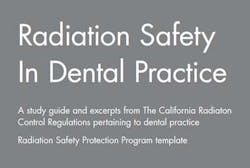California Dental Association updates radiation safety guide
Feb. 13, 2014
3 min read
The California Dental Association recently updated its Radiation Safety in Dental Practice guide, which contains the regulations applicable to dentistry and a template for completing a written safety program. All sources of radiation must have a copy of the radiation regulations and a written radiation safety program. To ensure compliance with state radiation regulations, CDA is encouraging all dental practices, clinics and dental educational programs to obtain the recently updated guide, which can be downloaded for free at cda.org. “Dentists have a responsibility to protect their patients and staff, and to make sure necessary exposures are kept as low as reasonably achievable (ALARA),” said CDA President James Stephens, DDS. “Familiarizing themselves with CDA’s updated Radiation Safety Guide is one way dentists can ensure they’re practicing safely.” With assistance from the Department of Public Health (DPH), dental school faculty members helped update the guide, which was first published in 1996. X-ray technology has changed considerably since then — digital systems are more common today and the use of cone beam computed tomography (CBCT) is increasing. However, the regulations themselves have changed little. Quality assurance regulations for X-ray film were adopted in 2012, and the DPH now requires all sources of radiation to have a written radiation safety program. Additionally, the use of protective aprons continues to be a requirement. The guide reviews the responsibilities of the licensed dentist and X-ray machine owner, as well as the essential principles for reducing patient and occupational exposure to radiation. A table summary of the ADA/FDA radiographic prescription guide that was updated in 2012 is included. The use of portable X-ray units and CBCTs is addressed. A section on dental monitor display and image quality considerations has been added. The radiation safety program template included in the guide allows the dentist or X-ray machine owner to fill in the necessary information. The template was created with the assistance of the DPH, which also has a guidance document on its website (cdph.ca.gov) to assist all X-ray machine registrants in developing a written radiation safety program. The Radiation Safety in Dental Practice guide is likely to be updated again in five years given the ongoing development in technology and usage and the expected publication of a supplement to the National Council on Radiation Protection and Measurements (NCRP), Report Number 145 (2004), Radiation Protection in Dentistry. The supplement will be released in 2015 or 2016.
About the Author
Sign up for our eNewsletters
Get the latest news and updates


